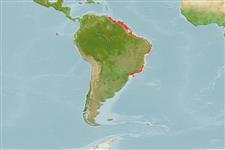>
Eupercaria/misc (Various families in series Eupercaria) >
Sciaenidae (Drums or croakers)
Etymology: Isopisthus: Greek, isos = equal + Greek, opisthe = behind (Ref. 45335).
More on author: Cuvier.
Environment: milieu / climate zone / depth range / distribution range
Écologie
marin; saumâtre démersal; profondeur 1 - 45 m (Ref. 3702). Tropical; 10°N - 27°S, 83°W - 34°W
Western Atlantic: Costa Rica to southern Brazil.
Length at first maturity / Taille / Poids / Âge
Maturity: Lm 15.9 range ? - ? cm
Max length : 41.5 cm TL mâle / non sexé; (Ref. 122735); common length : 20.0 cm TL mâle / non sexé; (Ref. 3702); poids max. publié: 740.00 g (Ref. 122735)
Épines dorsales (Total) : 8 - 9; Rayons mous dorsaux (Total) : 19 - 20; Épines anales: 2; Rayons mous anaux: 18 - 19. Silver grey, darker above. A diffuse black spot at pectoral-fin bases, fins pale to yellowish. Mouth large, strongly oblique, lower jaw projecting. Upper jaw with a pair of large canine-like teeth at tip. Chin without barbel or pores, lower margin of snout with 2 marginal pores. Two widely separated dorsal fins. Gas bladder with a pair of horn-like anterior appendages. Sagitta (large earstone) moderately thick and oval (Ref 51721).
Found in shallow coastal waters over sandy mud or soft mud bottoms (Ref. 3702). Feeds mainly on small shrimps (Ref. 3702). Important food fish.
Life cycle and mating behavior
Maturities | Reproduction | Spawnings | Egg(s) | Fecundities | Larves
Cervigón, F., 1993. Los peces marinos de Venezuela. Volume 2. Fundación Científica Los Roques, Caracas,Venezuela. 497 p. (Ref. 9626)
Statut dans la liste rouge de l'IUCN (Ref. 130435)
Menace pour l'homme
Harmless
Utilisations par l'homme
Pêcheries: intérêt commercial mineur; appât: usually
Outils
Articles particuliers
Télécharger en XML
Sources Internet
Estimates based on models
Preferred temperature (Ref.
123201): 24.8 - 27.9, mean 27.4 °C (based on 110 cells).
Phylogenetic diversity index (Ref.
82804): PD
50 = 0.7500 [Uniqueness, from 0.5 = low to 2.0 = high].
Bayesian length-weight: a=0.00794 (0.00727 - 0.00868), b=3.07 (3.05 - 3.09), in cm total length, based on LWR estimates for this species (Ref.
93245).
Niveau trophique (Ref.
69278): 4.0 ±0.4 se; based on diet studies.
Résilience (Ref.
120179): Milieu, temps minimum de doublement de population : 1,4 à 4,4 années (Preliminary K or Fecundity.).
Fishing Vulnerability (Ref.
59153): Low to moderate vulnerability (32 of 100).
Nutrients (Ref.
124155): Calcium = 209 [116, 401] mg/100g; Iron = 1.19 [0.63, 2.15] mg/100g; Protein = 19.3 [18.1, 20.4] %; Omega3 = 0.269 [0.138, 0.466] g/100g; Selenium = 43.8 [22.6, 88.2] μg/100g; VitaminA = 23.3 [8.3, 72.3] μg/100g; Zinc = 1.4 [1.0, 2.0] mg/100g (wet weight);
